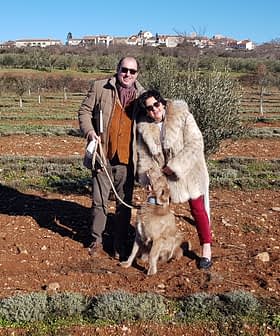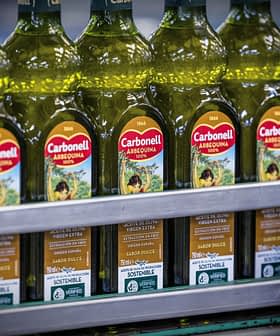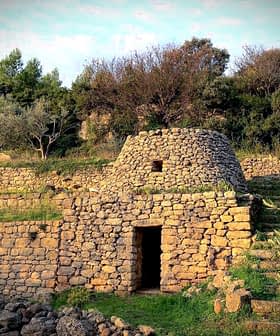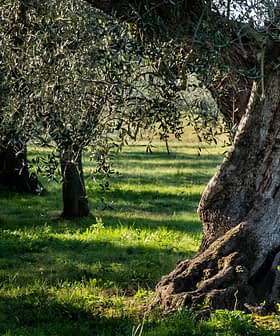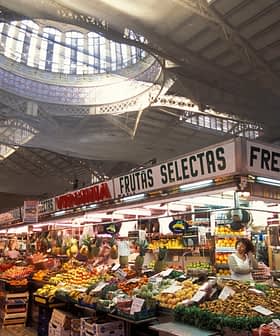Stewardship and Excellence at García de la Cruz
Five generations of the García de la Cruz family have a hand in their award-winning brand from La Mancha.
Fernando García de la Cruz walks through the olive trees at his estate near Madridejos, in the province of Toledo of Castilla-La Mancha region in Spain.
We haven’t done it all, not at all. If those before us wouldn’t have laid the basis, most certainly, this wouldn’t be as it is.
Workers are collecting the olives for the early-harvest oils. They combine the traditional “vareo” –- hitting the branches with a long stick — with the faster harvesting tractors that shake the trees until the fruits drop to the canvasses covering the ground.
We are in the first days of the harvest and the olives boast a bright green color.
“I remember when I was 12 years old, my dad used to take me to the factory during the Christmas holidays to weigh olives. I’ve grown up in this sector. I saw it on my dad I saw it on my grandmother. They saw it on their ancestors,” De la Cruz tells Olive Oil Times.
Along with his brother Eusebio, Fernando is the CEO of García de la Cruz. Their company was founded in 1872. Now, almost 150 years later, it is still a family business.
“The company was founded by my great-great-grandparents. We can say we are one of the oldest oil mills in Spain. We are the fifth generation of olive growers and oil millers,” Fernando proudly says.
A few years ago, Eusebio moved to New York in order to internationalize the company. With a delegation on the East Coast, the company also has a commercial office in Portland.
García de la Cruz’s olive groves are set in an area where the plains of La Mancha in Central Spain meet the foothills of the Mountains of Toledo.
Almond trees, cereals and vineyards alternate with olive groves. The hills nearby are crowned by whitewashed windmills and the magnificent castle of Consuegra overlooks the landscape.
Although far behind Andalusia, La Mancha is the second-largest oil-producing region in Spain.
This is the land of the Cornicabra — the most typical cultivar in the area. 90 percent of the 400-hectare estate of García de la Cruz grow this variety.
“The Cornicabra cultivar in our region is under the umbrella of the Toledo Mountains Protected Origin Denomination. It has very special particularities such a high content in polyphenols and oleocanthal. This makes the oil from this cultivar one of the most stable and healthiest in the world,” García de la Cruz explains.
Their Master Miller García de la Cruz oil won a Best in Class Award at the 2019 NYIOOC World Olive Oil Competition for its organic medium blend of Arbequina, Picual, Hojiblanca and Cornicabra.
“100 percent of our olive groves are organic,” García de la Cruz says.
Actually, a good part of the company’s land lies within the limits of a special protection area for wild birds belonging to the Natura 2000 network, a group of protected sites across the European Union.
“This oil is produced in an area where respect for biodiversity is promoted. Having life in the undersoil of the olive groves is very important for us. We must leave this kind of olive grove to our kids in exceptional conditions,” García de la Cruz suggests.
Apart from growing and treating their olive trees according to organic standards, some years ago the company started producing its own organic fertilizers using the pomace or alperujo — a byproduct of the olive milling process consisting of what is left from the olives once their oil and seeds have been extracted — as a base.
“We are very happy with these products which allow us to reuse and recycle part of the waste of the olive oil production,” García de la Cruz says.
He also highlights the importance of saving water in an area with an annual average of rainfall of just 200 liters per square meter.
“We water 30 percent of our olive groves. But we are in the ‘dry Spain.’ This makes us conscious to use water wisely. We have installed sensors underneath the soil, at a range of depths, that let us know the degree of humidity and help us to save water,” García de la Cruz explains.
When asked about the future or his company, García de la Cruz looks back at his family’s history, as if the answer were in its long tradition as olive oil producers.
“We’re the fifth generation. The sixth is getting ready. They are already at the university. And my greatest hope would be to leave all this to my children and my nephews so they continue what the previous five generations have done,” he told us.
“We haven’t done it all, not at all. If those before us wouldn’t have laid the basis, most certainly, this wouldn’t be as it is.”

